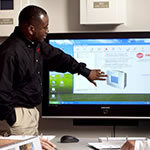The Industrial Revolution gave the world railroads, steam power, steel, mechanization, and mass production. It also helped create industrial manufacturer Ingersoll Rand, which was founded in 1871 as Ingersoll Rock Drill Co. In the 143 years since, the fruits of the Industrial Age have fueled consistent and continuous growth at Ingersoll Rand, which manufactures HVAC systems, compressed-air solutions, and refrigeration equipment through numerous brands, including American Standard, Thermo King, and Trane.
Because it was born during the last great revolution, Ingersoll Rand paid close attention when trendspotters began forecasting the next one: sustainability. In order to remain relevant, the company’s leadership realized that it had to not only get ahead of the change but also help drive it. As a result, it subsequently commenced its own revolution, establishing an internal body—known as the Center for Energy Efficiency and Sustainability (CEES)—to help both the company and its customers embrace sustainable business practices.
“The Harvard Business Review in 2010 published an article in which it called sustainability the next ‘megatrend,’” recalls CEES executive director Scott Tew. “Megatrends only come around once every few generations, and they have the capacity to fundamentally change how we live. One of the last big megatrends was the Industrial Revolution, and Ingersoll Rand was at the very center of it. If the next one is sustainability, we asked ourselves, ‘What can we do to make ourselves more sustainable?’”
CEES consists of a six-person staff and an 11-person advisory council, members of which lead internal conversations about sustainability leadership, infrastructure development, energy policy, and technology. Although it’s less than five years old, the group already has made a significant impact on the business by helping it integrate sustainable thinking into almost everything it does. In particular, its priorities are divided into three broad focus areas: behavior modeling, products, and storytelling.

Urban Eden was 2013’s Solar Decathlon entry from UNC–Charlotte. Ingersoll Rand was a major project sponsor.
Tew refers to behavior modeling as “walking the talk.” Activities encompass everything from how the company trains its employees to how much energy and water it uses in its manufacturing process. Ingersoll Rand also is actively greening its portfolio of products, according to Tew, who says the company is focused on developing products that continue to meet customers’ needs, but with less energy and a reduced environmental footprint. And then, getting the word out about its sustainability journey is paramount. Tew says thought leadership is a major priority for Ingersoll Rand, which wants to leverage its brand to establish benchmarks that help other companies successfully integrate sustainability.
One of CEES’s most significant achievements to date is Ingersoll Rand’s Design for Sustainability training, which is a certificate program for the company’s product-development teams created in partnership with UL Environment.
“We realized it wasn’t going to be enough just to rally our people internally around the concept of sustainability. To meet our goals, we also had to train them in some new competencies,” Tew says. “So, we developed a one-of-a-kind training program for our design engineers, procurement professionals, and product managers.”
The program, which is Ingersoll Rand’s exclusively for one year, teaches participants how to integrate sustainability into every aspect of product development, from initial conception through final execution. The result, if its successful, will be future products that benefit both users and the environment.
“We’re questioning things we’ve never questioned before,” says Tew, who notes that manufacturing processes and material selection are top-of-mind. “For instance, all of our future products now go through a lifecycle assessment. We’re starting to think more and more about what happens at the end of life. How do you make a product that’s more serviceable throughout its life? How do you design in a way that allows you to take part of the product back and reuse it? What will happen to the parts you can’t take back?”
Although sustainability is in many ways still in its infancy at the company, Ingersoll Rand is confident that its efforts will put it at the center of the impending revolution.
“As cities get bigger and the need for ever-scarce resources increases, we have a question in front of us,” Tew says. “Are we willing to give something up, or can we find new ways to enjoy the quality of life we all like to enjoy? I like to think Ingersoll Rand has a partial answer: solutions that allow us to use fewer resources and still have a high quality of life.”

